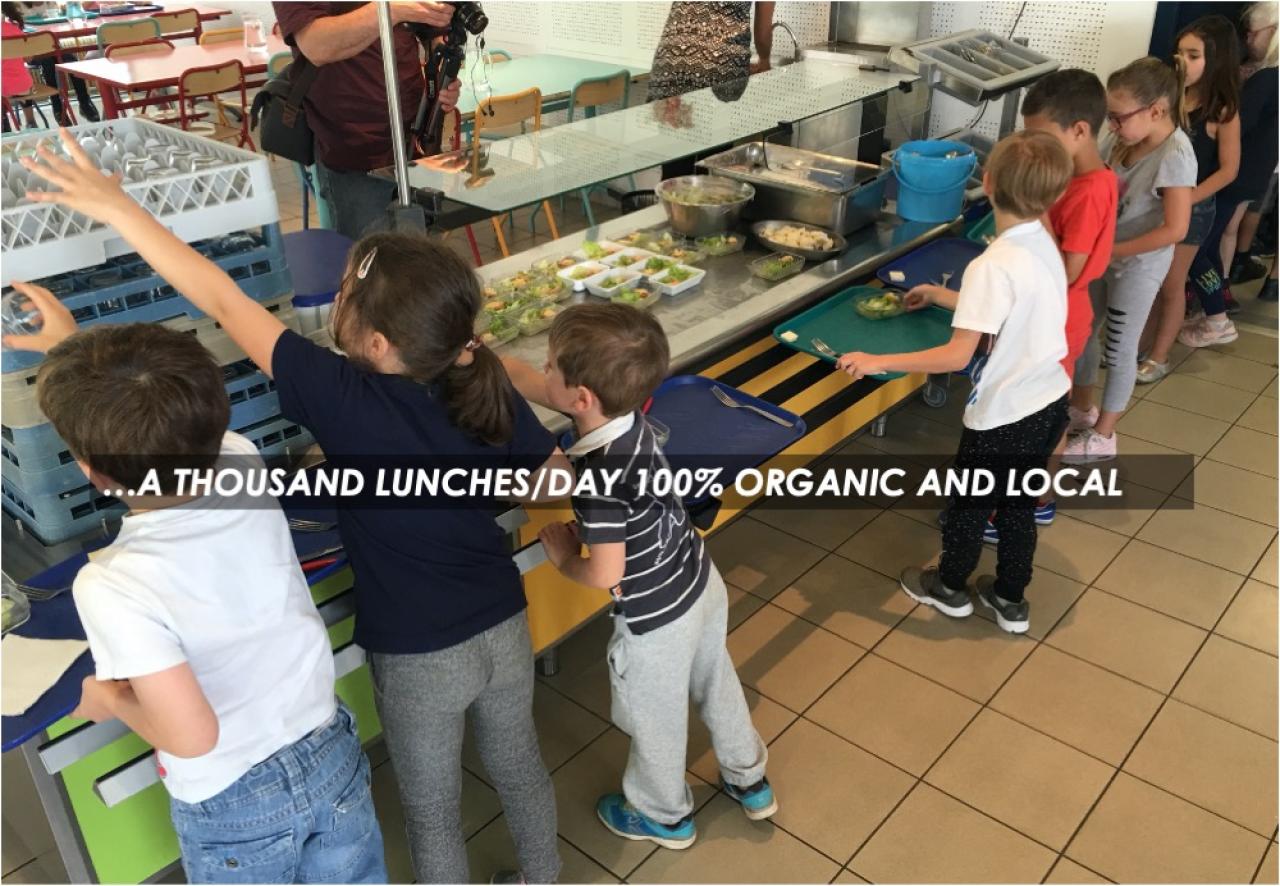
3 primary schools’ canteens in the city and a thousand lunches par day 100% organic and mostly local with no cost increase! That the magic of the Good Practice of Mouans-Sartoux, a small sustainable city, surrounded by the rather unsustainable French Riviera, where it’s all about real estate interest, high pressure on land use and mass tourism.
BioCanteens#1 focused on ensuring the distribution of sustainable school meals in participating cities as a key lever towards the development of an integrated local agri-food approach, protecting both citizens’ health and the environment.
The Good Practice of Mouans-Sartoux is based on the daily distribution of meals that are 100% organic and mostly composed of local products, an 80% reduction of food waste thereby fully compensating the higher cost of switching to organic products, the introduction of plant proteins in menus, and the organisation of dedicated educational activities to raise children’s and families’ awareness about sustainable food and the positive effects on local agriculture.
This first wave URBACT Transfer Network aims to transfer Mouans-Sartoux’s Good Practice in the field of collective school catering, to other 6 cities across Europe (Pays des Condruses in Belgium, Rosignano-Marittimo in Italy, Torres Vedras in Portugal, Trikala in Greece, Troyan in Bulgaria and Vaslui in Romania), to learn from them in return and from the co-design of a transfer methodology as well.
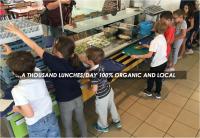
The movement of European’s cities engaged for food democracy and sovereignty
Mouans-Sartoux’s Good Practice is a real solution within a larger political initiative, redressing the balance of political leverage on food that has enabled European cities social and economic development for centuries until regions took over and the subsequent eruption of private companies excluded cities from this preponderant role.
Thanks to outstanding programs and international bodies and in particular the Glasgow food and climate declaration, the Milan Urban Food Policy Pact organizing its 7th global forum in Barcelona but also the RUAF (Resource centres on Urban Agriculture and Food) Foundation, the International Urban Food Network, cities are now re-claiming their influence over food policy via initiatives like the one led by Mouans-Sartoux.
The fact that Mouans Sartoux works on the topic of sustainable food reflects a sustainable integrated approach to urban policy. It responds to a range of interrelated needs with a closely integrated response: school catering, health, employment, urban planning, agriculture, education, public procurement, environment, etc.
The BioCanteens’ Good Practice in a nutshell
Unfortunately, too often throughout Europe canteens’ meals are provided by catering services managed by large companies serving low-quality food based on ready-made products from central kitchens. This implies limited local employment, increased transportation costs with the subsequent impact on the environment, and centralized decisions. In many European cities, collective restaurants represent an important share of the power of purchase. Cities tends, with their procurement policy, to facilitate a healthier public food-provisioning programme and thus influence the local agriculture development positively.
Mouans-Sartoux’s Good Practice shows a very strong systemic dimension very well rooted into its territory and in particular focusing 5 different dimensions.
Sustainable KITCHEN and food waste management: the shift of canteens to local and organic meals means big changes in the kitchen staff practices, for eg: training to prepare meals from scratch, cooking on demand to reduce food waste, tight coordination between kitchen staff and canteen educators watching children during meals to adjust recipes to their tastes, etc.
Healthy food EDUCATION and sustainable behaviour change: the school’s canteen is also a complete “food school” for the children and their families, including food education during meals, choices between portion sizes to get them used to finish their plate, tasting and cooking classes, gardening activities and visits to the municipal farm. Beyond canteens, a city food and health education program aims at shifting families’ habits to local and organic food.
Sustainable URBAN PLANNING and agricultural land use: increased synergies between the Agenda 21 sustainable territorial plan, the local sustainable urban planning plans (referred as POS/PLU/PADD in the French urban planning system) and the local food health education plan (called PEL) resulted in more than 4 decades of careful urban planning, systematic acquisition of available land, concentration of urban development against urban sprawl and the creation of a municipal farm supplying the canteens.
Food-related LOCAL ECONOMY and job creation: beyond the municipal farm, the provision of 135 hectares of municipally owned land generated the development of local agriculture, supporting with subsidies the installation of new organic farms and a potential of 50 to 100 new jobs in the sustainable food-related local economy.
Sustainable integrated GOVERNANCE: more than 45 years of political engagement led to the establishment of consistent food territorial management and to the creation of the Maison de l’Education à l’Alimentation Durable or Centre for Sustainable Food and Education (MEAD) with 5 routes leading the city’s food and health sustainable program: Encouraging new agricultural settlements; Transformation and conservation of food; Raising awareness about sustainable food; Support for research projects and Communication and networking.
Canteens’ schemes at the core of the local transition
Beyond the canteen scheme and territorial food governance discussed here, the city of Mouans-Sartoux has an outstanding sustainable ecosystem. It’s a “real utopia” for André Aschieri, its former Mayor, whose inspired sustainable and integrated leadership guided the city for more than 45 years of coherent and meaningful governance.
The health and food program is integrated in all dimensions of the city from social affairs (i.e. improving the quality of local food aid, offering access to family plots or promoting the city Fair Trade label) to culture (i.e. leveraging on the yearly Book Festival to invite leading world-known figures of sustainable development such as Vandana Shiva, Pierre Rahbi, Cyril Dion, etc.) or economic development (i.e. support to the creation of complete local organic food chain).
The city of Mouans-Sartoux seems to embody the motto: ‘think global, act local’. The governance is fed and inspired by its engagement at multiple levels: regional (i.e. Agribio06, regional network of organic agriculture), national (i.e. Un Plus Bio network for quality food in canteens), European (i.e. partner in URBACT AgriUrban, hosting a National URBACT Point meeting, Lead Partner of BioCanteens #1 and now of BioCanteens#2) and international (i.e. founding member of the Organic Food Territories Network and partner of the Organic Food System Programme of the FAO, Food and Agriculture Organisation of the United Nations focusing on sustainable “agri-food” systems). Equally this engagement in networks, think tanks, and conceptual, reflective projects at higher governance levels does not stay academic or hypothetical, but rather comes together, finding concrete solutions at city level.
Main lessons from BioCanteens#1
A bottom-up decomposition of the Good Practice
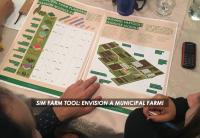
At the core of Mouans-Sartoux’s Good Practice stands a “municipal farm”. Almost an oxymoron for certain partner cities, since the idea of a public player involved in agricultural production to supply its own canteens seems so far-fetched, or the implementation of a farm managed by municipal agents seems impossible. The municipal farm is a key asset to supply canteens with organic vegetables and fruits in the context of a very urbanised territory around Mouans-Sartoux lacking local agriculture production. Even for BioCanteens#1’s city partners with a rural hinterland and rich agriculture for their canteen supply, the idea of setting up a municipal farm triggered high interest. Beyond organic production each city enriches the municipal farm concept with different interpretations: a demonstrator of local organic farming to engage with the local agriculture sector, encourage organic conversion, support local practices and arouse vocation of new farmers; a pedagogical farm to receive school children, families but also to raise awareness on agriculture stakes among politicians and local decision makers; a social asset to engage socio-dependant people and provide jobs; a cooperative resource to pool small local farms and offer food transformation facilities. “Sim-farm”, a construction set made up of ten main components of a municipal farm as discussed and identified by the network’s partners allow new cities participating to BioCanteens#2 to simulate the farm that the city interested in, to make it a little tangible and credible, so that the stakeholders represent it and that from a chimera it becomes an object of discussion.
This bottom-up apprehension of the transfer is one of the key lessons learned from BioCanteens#1: helping city partners to picture out how they each understand the positive dynamics happening in Mouans-Sartoux; organizing a collective and bottom-up decomposition of the Good Practice into a series of 8 Transfer Modules that could be transferred (or not) by each city according to its own profile and to its transfer expectations.
Transfer starters and transfer enablers
The modules were carefully co-designed to facilitate the transfer either as easy access entry points or as local context facilitators. We call them respectively transfer starters and transfer enablers. For instance, the Good Practice revealed a large number of small-scale actions all along the canteen process from meal preparation in canteens’ kitchen (to reduce impact, facilitate the cooking process from scratch, minimize wastes, etc.) till the service and eating in the refectory (i.e. canteens educators interacting during meals; children sorting and weighing food waste after each meal; specific teaching sessions around growing and cooking food as after-school activities or within the school class, etc.). These so-called Canteens Micro-Good Practices work as “transfer starter” allowing cooking staff and canteens educators to implement easy to reach entry steps, key to engage stakeholders and kick-start the transfer. They also rep- resent a step-by-step change of daily ways of doing that, in the long run, represent a deep change carried by the stakeholders on the field.
Setting intermediary transfer goals to reach
The design of each module also includes the definition of Transfer Milestone or intermediary results likely to prompt the local strategic conversation and to help the decision-making process to keep the transfer momentum on the long run. They are first tangible self-standing outputs achievable within the transfer period and a step towards further transfer and implementation of the module beyond the transfer period. For example, the question of land use and the issue of accessible local farmland within a reasonable reach of urban areas is key to ensure the maintenance of enough local food production and a certain level of food security and self-determination for cities. The Food Sovereignty Vision Transfer Module includes as a first step, a light but emblematic mapping exercise of good agricultural land still available around the city and a projection of what will be necessary in the coming decades to ensure a certain level of food sovereignty of the future city population. Posters from the mapping should be printed by each city and displayed in key places (i.e. schools, City Hall, Parents’ Association, Chamber of Agriculture, etc.) to prompt the strategic conversation on the necessity of sustainable land management.
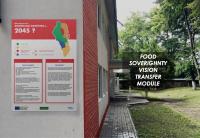
Developing a BioCanteens’ specific toolbox
The co-elaboration of the transfer with the first BioCanteens’ city partners was also the occasion to design Transfer Tools to support the engagement of the cities as ambassadors of organic and local canteens in their respective countries. For instance, the Transfer Timeline is a successful “transfer dashboard” progressively co-designed and improved: in consists in a timeline or rather eight parallel lines, each corresponding to the evolution of one of the transfer modules. Transfer Timieine tool works like a informal PERT planning, as a visual monitoring instrument, flexible and light, stimulating narration, interaction and also “coopetition” in the network“ pointing out deadlines, delays, problems of articulation... “We can take regular stock of the progress of each module, says Giuseppe Schiavone, local coordinator of Rosignano Marittimo, but it is above all what happens between the modules that is important and how it all interacts with everything else that is happening in the territory...” After two years of work, each “Transfer Timeline” unfolds like a film, a story of the transfer in a didactic video of a few minutes...
BioCanteens’ Ambassadors
half-way from the 2-years transfer Period, most of the BioCanteens cities seem to have found their specific different ways to receive the Good Practice, to make sense with it and to be able to be- come, in their turn, Ambassadors of it at regional or national level in their respective countries. BioCanteens cities leveraged on their collaboration and achievements in this URBACT Transfer Network to raise their Final Event to European level, stating that for some advanced cities the “COP26 is already happening” and inviting other cities to “Join the Movement of European Cities Engaged for Food Democracy and Sovereignty”. This event allowed to share the BioCanteens Transfer Network experience, to highlight how European cities, regardless of their size or location, are concretely acting as leaders in building resilient local food systems and to call on the European Parliament to consider the need for a food exception in public procurement.
4 BioCanteens#2 city partners assets and expectations

Food heritage and local farms to supply canteens in Evora, Portugal
"Our food project for the canteens includes a cultural component that we think is particularly important” explains Sara Fernandes, former Deputy Mayor in charge of education and schools’ canteens of Evora, a city of around 50,000 inhabitants of the Alentejo, one hundred of kilometres to the east of Lisbon. “The Alentejo has a great gastronomic tradition of legume-based soups that represent a potential for a healthy diet for children and a cultural capital to preserve. Today, families add animal proteins, grass broths, and ground potatoes… With a nutritionist, we have revised all the traditional recipes that use our kitchens to arrive at seasonal technical sheets, vegetarian menus and festive menus". One other great asset of Evora in terms of canteen is to produce about 1800 meals a day in about 40 primary schools in direct management, which is to say with kitchens in the schools and in each, a chef with one or two assistants which prepares between 200 and 400 meals from fresh and mostly raw ingredients.
Canteens as part of the 2021 sustainable food “movida’ in Gavà, Spain
"Our objectives in BioCanteens#2 are to improve our local food system to ensure more sustainable, local and healthy food in school canteens but also for all our inhabitants. This project will help us rolling out our recent City Food Strategy” Ester Zamorano, Deputy-Mayor of Gava explains why the topic of sustainable food is now at the top of the political agenda of this city of around 47 000 inhabitants, marked by an important agricultural activity and identity but also by the great urban pressure in the outskirts of Barcelona.
Food is now at the top of the agenda in the region with the adoption of the Barcelona Metropolitan Food Charter in March 2021, as well as with Barcelona being the 2021 World Capital of Sustainable Food and hosting city of the 7th Milan Urban Food Policy Pact Global Forum at the end of October 2021. Boosted by this local context, but also taking stock of previous strategic documents around sustainable food, the city of Gavà decided to work on and launch its own City Food Strategy for Sustainable, Accessible and Healthy Food based on three main objectives: providing sustainable and healthy diets for all, fighting the climate emergency, and boosting the local economy.
A civil society powerful food movement in Liège, Belgium
“You are pioneers, we are all pioneers!” claim Florence Henrard, in charge of sustainable canteens mission at the Ceinture Aliment-Terre Liègois, Liège Food Belt, a network of food-related stakeholders promoting local food producers, sustainable and fare short supply chain.
“In Liège, the motivation of the associations, of the inhabitants, and of the city administration is no longer necessary to be demonstrated!”. Willy Demeyer, the Mayor of Liège has confidence in the city assets towards a more sustainable local food system: City Food Council, Centre for Sustainable Food and Inclusion, Short Circuits food market, yearly food transition festival Feeding Liège, etc.
He shows also a clear vision on progress to be made: federation of local food producers to supply the city canteens, improving quality of meals for all the city large scale canteens scheme, improving ability to work with public procurement to favour local producers, even showing public exemplarity with the development of a municipal farm in Liège... all important objectives that need to be implemented!
A canteens schools’ scheme in transformation in Wroclaw, Poland
” We are not yet at that level of quality of providing organic food. We are already very proud that 100% of our schools are certified! “, declares Joanna Nyozak, Head of city’s Health Office, Wroclaw, the 4th city for its population in Poland. She refers to work carried out with Wroclaw University to define a certification system for the food and nutritional quality of the city's schools, with three levels: bronze, silver and gold, which has enabled the city's somewhat eclectic and uneven canteen to catch up and engage in a process of transformation.
”In most of the canteens, children have at best 20 minutes and sometimes only 15 minutes to eat. Even if they wanted to, they don't have enough time to finish their plates!" For Makgorzata Jakubiak, Intendent of Primary School No. 46, the city's canteens have a problem with the size of the kitchens and the lack of space for the dining hall. The congestion of schools and reduction of mealtime is one of the reasons for high food waste in the city canteens’ schools on top of apparent rigidity of the rules governing canteens’ processes in Poland: predefined portions according to the age of the children, a ban on giving unserved meals to charities, the impossibility of preparing less than what has been planned, etc.
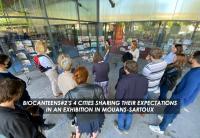
Upscaling factor from 6 to 60!
What is the added value of this BioCanteens “second wave”? Some of the partner cities in BioCanteens #1 were from 5 to 8 time larger in population compared to Mouans-Sartoux were already chosen to demonstrate that the Good Practice was not bind to smaller size cities. In BioCanteens #2, with Gavà 47 000 inhabitants, Evora 57 000, Liège 626 000 and Wroclaw 636 000 the upscaling challenge for the transfer jumped to 6 and 60!
Nevertheless, the 4 city partners show some converging expectation starting with reducing a rather important level of food waste that represent an important potential of financial economy and of involvement of stakeholders. Working with public procurement is also necessary for the partner cities to favour small local producers and improve sustainability of canteens still complying with European procurement rules. A form of local farmer-driven canteens’ supply should balance current top-down ordering processes leaving not enough flexibility to comply with small suppliers’ contingencies. Local eating habits and traditional gastronomy should be revisited to keep the local food heritage and translate it into healthy canteens menus. The evolution of kitchen staff practices should be supported with training sessions to help them adopt the expected evolutions. Finally, the participation to the BioCanteens’ transfer process and the constitution of ULG’s is seen as an important occasion to strengthen local stakeholders’ process.
What are the ambitions for BioCanteens#2?
BioCanteens#2 raises important challenges for the transfer, some already present in BioCanteens#1 and some others that are new and represents also potential improvements for the transfer city Mouans-Sartoux. The first and main challenge is an important mistrust in organic certification that should be investigated, discussed in order to overcome the paradox for the 4 “second wave” transfer cities to take part in BioCanteens if they are not convinced to go bio/organic. “We need BioCanteens to help us to better understand these issues and be able to evolve our position” expect Sara Fernandes, former Deputy Mayor of Evora.
The 4 city partners have shown a large and rich range of promising initiatives that need now to bridge the gap between small scale experiments and city canteens’ scheme size. Liège in particular, with its dynamic civil society with 400 persons involved, 200 projects in 10 years since the Liège Food Belt has been launched, is questioning the up-scaling moto inherited from industrial model and suggest to explore other ways to mainstream good practices and promising initiatives through ”out-scaling”: multiplication of small scale solutions rather than forcing them to grow, better adaptation to each different contexts towards more local resilience, etc.
Finally, a balance between keeping high ambitions and still reaching significative transfer evidences and 18 months should be carefully reflected in the respective cities Transfer Roadmaps. In particular, established canteens’ infrastructures may represent limits that will not be able to be changed within the framework of the Transfer Network process.
Written by: François Jegou, BioCanteens#2 Lead Expert
Download this Article in the PDF VISUAL AMAZEMENT Format

